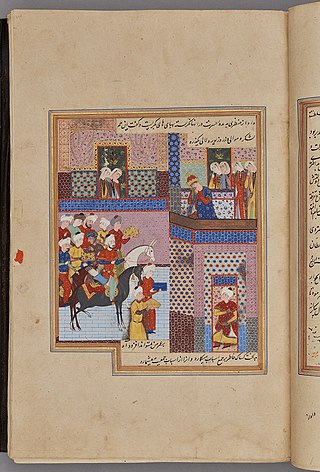
The Zengid or Zangid dynasty was an Atabegate of the Seljuk Empire created in 1127. It formed a Turkoman dynasty of Sunni Muslim faith, which ruled parts of the Levant and Upper Mesopotamia, and eventually seized control of Egypt in 1169. In 1174 the Zengid state extended from Tripoli to Hamadan and from Yemen to Sivas. Imad ad-Din Zengi was the first ruler of the dynasty.

Mughith al-Dunya wa'l-Din Mahmud bin Muhammad known as Mahmud II was the Seljuk sultan of Baghdad from 1118–1131 following the death of his father Muhammad I Tapar. At the time Mahmud was fourteen, and ruled over Iraq and Persia.

The Kart dynasty, also known as the Kartids, was a Sunni Muslim dynasty of Tajik origin closely related to the Ghurids, that ruled over a large part of Khorasan during the 13th and 14th centuries. Ruling from their capital at Herat and central Khorasan in the Bamyan, they were at first subordinates of Sultan Abul-Fateh Ghiyāṣ-ud-din Muhammad bin Sām, Sultan of the Ghurid Empire, to whom they were related, and then as vassal princes within the Mongol Empire. Upon the fragmentation of the Ilkhanate in 1335, Mu'izz-uddin Husayn ibn Ghiyath-uddin worked to expand his principality. The death of Husayn b. Ghiyath-uddin in 1370 and the invasion of Timur in 1381, ended the Kart dynasty's ambitions.

The Sarbadars were a mixture of religious dervishes and secular rulers that came to rule over part of western Khurasan in the midst of the disintegration of the Mongol Ilkhanate in the mid-14th century. Centered in their capital of Sabzavar, they continued their reign until Khwaja 'Ali-yi Mu'ayyad submitted to Timur in 1381, and were one of the few groups that managed to mostly avoid Timur's famous brutality.

Rukn al-Din Abu'l-Muzaffar Berkyaruq ibn Malikshah, better known as Berkyaruq (برکیارق), was the fifth sultan of the Seljuk Empire from 1094 to 1105.
Shams al-Din is an Arabic personal name or title.
Shams al-Din 'Ali ibn Mas'ud ibn Khalaf ibn Mihraban was the first Mihrabanid Malik of Sistan. He ruled from 1236 until his death.
Qutb al-Din Muhammad was the Mihrabanid malik of Sistan from 1330 until his death. He was the son of Rukn al-Din Mahmud.
Taj al-Din was the Mihrabanid king (malik) of Sistan from 1346 until 1350. He was the son of Qutb al-Din Muhammad.
Jalal al-Din Mahmud was the Mihrabanid malik of Sistan from 1350 until his death. He was the son of Rukn al-Din Mahmud.
Qutb al-Din was the Mihrabanid malik of Sistan from 1380 until 1383. He was the son of Izz al-Din ibn Rukn al-Din Mahmud.
Nusrat al-Din Muhammad was the Mihrabanid malik of Sistan from 1318 until his death. He was the son of Nasir al-Din Muhammad.

The Mihrabanid dynasty was a Muslim dynasty that ruled Sistan from 1236 until the mid-16th century. It was the third indigenous Muslim dynasty of Sistan, having been preceded by the Saffarid and Nasrid dynasties.
Taj al-Din Shah-i Shahan Abu'l Fath or Shah-i-Shahan of Sistan was the Mihrabanid malik of Sistan from 1383 until his death. He was the son of Mas'ud Shihna.
Qutb al-Din Muhammad was the Mihrabanid malik of Sistan from 1403 until his death. He was the son of Shams al-Din Shah 'Ali.
Nasir al-Din Muhammad was the Mihrabanid malik of Sistan from 1261 until his death. He was the son of Mubariz al-Din Abu'l-Fath ibn Mas'ud.
Sultan Mahmud was the last Mihrabanid malik of Sistan from c. 1495 until c. 1537.
Qutb ad-Din or Qutb-ud-Din is an Arabic male given name translated as 'the pivot of the faith' or 'axis of the faith'.

Muhammad II ibn Mahmud was Sultan of Seljuq Empire from 1153 to 1159. He was son of Mahmud II and brother of Malik-Shah III. The Cambridge History of Iran notes that Sultan Muhammad "tried energetically to restore the slipping authority of his dynasty in Iraq".






